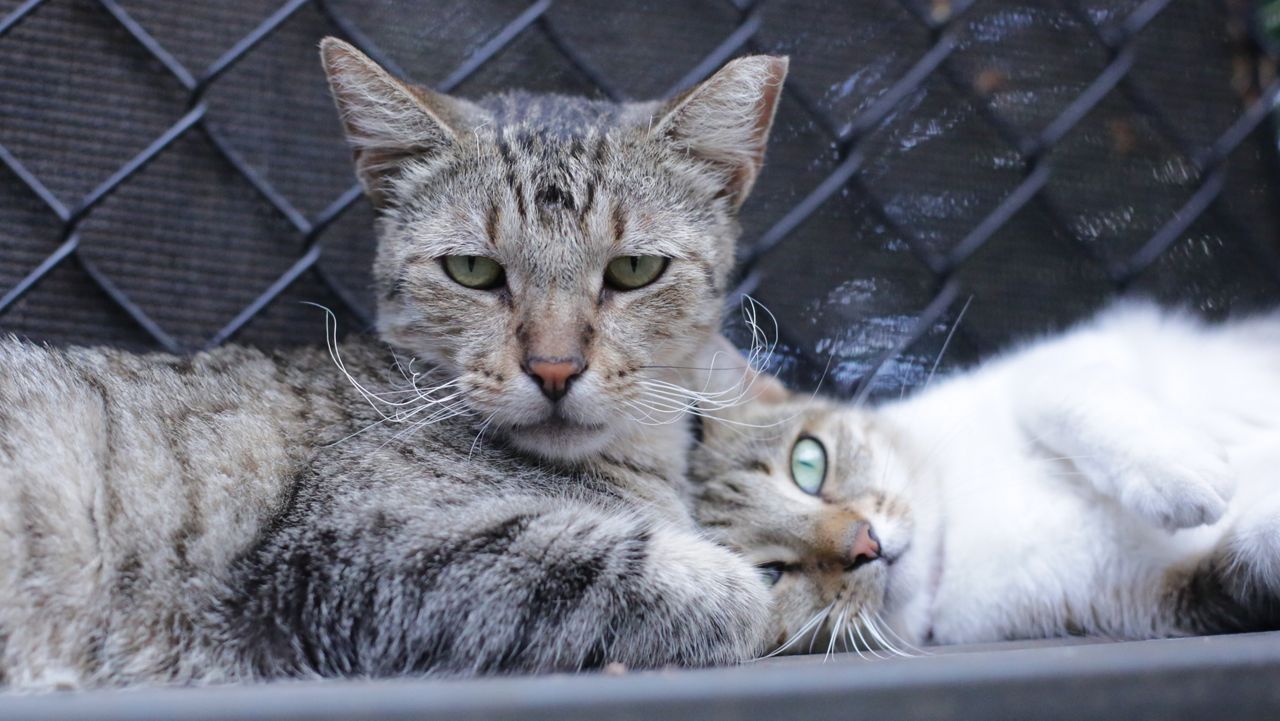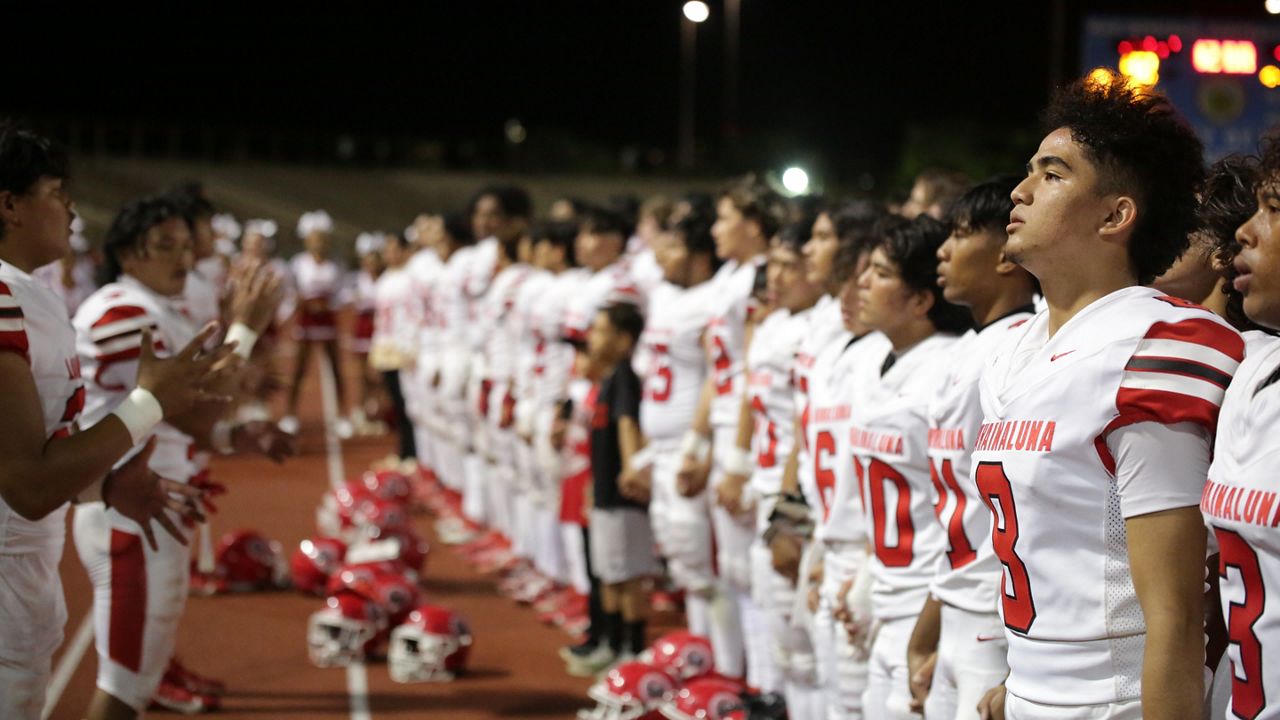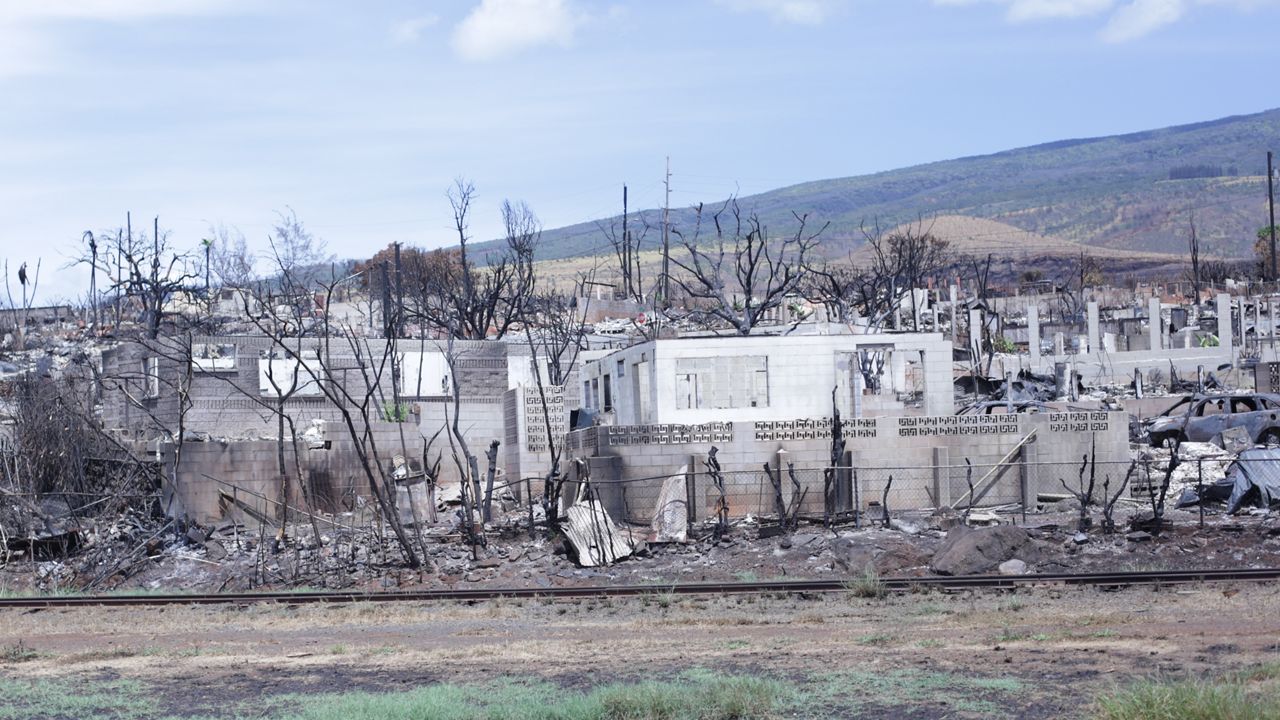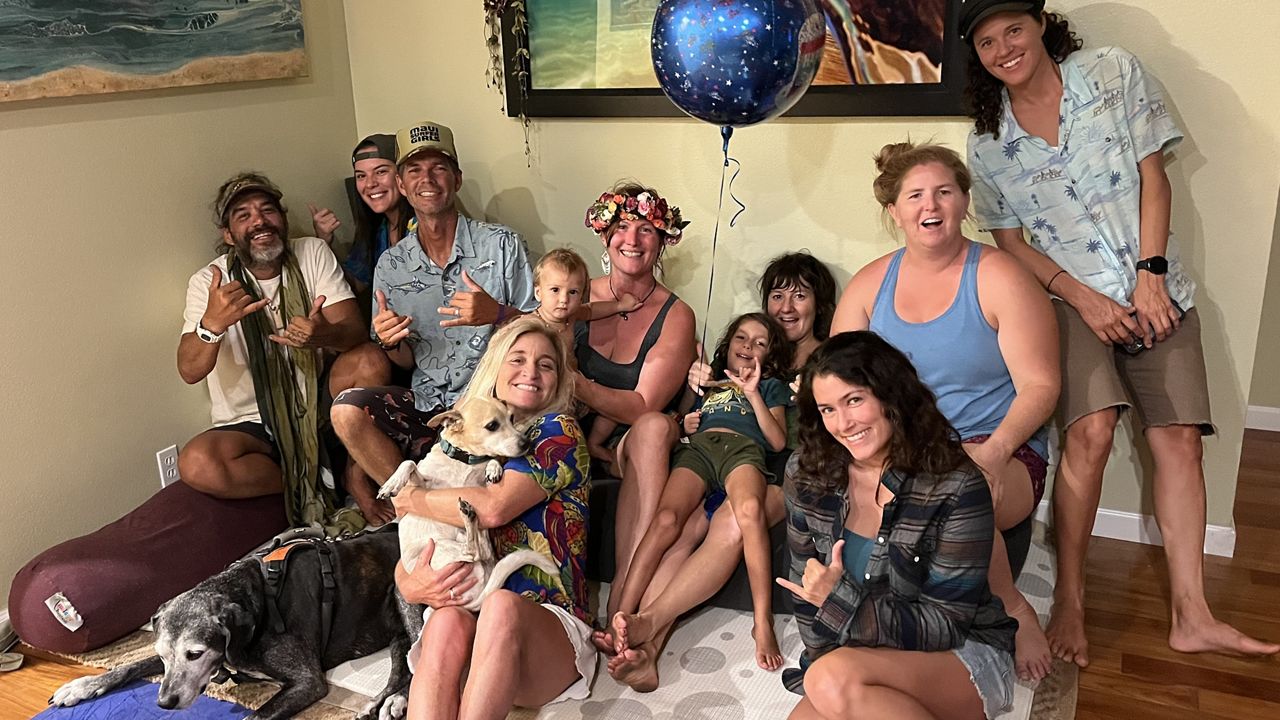The Aug. 8 wildfires in Lahaina and Kula killed 100 people and forever changed Hawaii. Spectrum News Hawaii flew from Oahu to Maui to cover the aftermath of the fires. As the year comes to a close, we are reflecting on the stories that impacted us most.
Invasive grasses growing in the abandoned plantations on Maui and Hawaii Island fueled the ongoing wildfires, according to a University of Hawaii at Manoa wildfire expert.
Clay Trauernicht, an Assistant Specialist at UH Manoa’s College of Tropical Agriculture and Human Resources, said land management is necessary to prevent future wildfires in Hawaii.
Wildfires on Hawaii Island and Maui, fanned by strong winds from Hurricane Dora, which is passing south of the state, have burned through the land. On Maui, the historic town of Lahaina was destroyed, with 1,700 buildings burned. At least 55 people have been killed in the fires, but Gov. Josh Green has said the number of dead was likely to rise.
In Hawaii over the past three decades, many sugar plantations, pineapple farms and ranches shuttered. Flammable grasses grew densely in the untended land.
Hot, dry and windy conditions all lined up over the last week, making the invasive grasslands “incredibly prone to burning,” said Trauernicht. “Weather conditions really contributed to the explosive behavior that we saw.”
Dry air sucks the moisture out of the grasses, making them burn swiftly and spreading the wildfire faster.
Lahaina was especially vulnerable because the slopes above it were grasslands. These invasive grasses grow right up to the edge of the community.
2 . Hawaii officials ask for patience and time for Maui recovery efforts
Hawaii officials are urging the public to be patient as Maui County deals with an unprecedented natural disaster.
“This is the largest natural disaster we’ve ever experienced. It’s going to take an incredible amount of time to recover from,” Gov. Green said.
The governor confirmed 89 fatalities Saturday, making it the deadliest U.S. wildfire in over a century. Maui County later raised the confirmed death toll to 100.
The wildfire caused destruction or damage to 2,200 structures, with 86% of them being residential in West Maui. In Kula, 544 structures have been “exposed,” with 96% of them residential.
“The losses approach $6 billion,” Green said.
“We ask for a lot of understanding about traveling into the (historic area of Lahaina town), and the reason for that are the health consequences. We have to go with caution. There are heavy metals there,” he continued. “The recommendations are to avoid structures because they could still fall on people. And we’ve lost so much life already.”
3. While Lahaina was burning, no sirens rang
Pa‘ele Kiakona, a Lahaina resident and community organizer, biked directly into the roaring inferno on Aug. 8, to rescue his grandmother, who did not know what was going on because of the absence of sirens.
Click the link above to watch a video of Kiakona talking about his experience on Aug. 8.
4. Andaya defends decision not to sound emergency sirens
Facing increasing criticism for his decision not to activate emergency sirens at the onset of the Maui fires, Maui Emergency Management Agency administrator Herman Andaya said Wednesday that he does not regret the decision.
“I do not,” he said, during a media briefing on Aug. 16.
Andaya said it is not standard protocol for his department to activate sirens for brush fires and it instead used the modes of communication it felt were more effective in the situation.
“The state-owned outdoor siren system is a tool that we can use and we’ve used it in the past,” Andaya said. “The system has not been used in Maui or in other jurisdictions around the state.”
According to the Hawaii Emergency Management Agency's website, "the all-hazard siren system can be used for a variety of both natural and human-caused events; including tsunamis, hurricanes, dam breaches, flooding, wildfires, volcanic eruptions, terrorist threats, hazardous material incidents and more."
5. HECO claims its lines were de-energized when deadly fire broke out
Hawaiian Electric said fallen power lines likely caused a fire in Lahaina on Aug. 8, just not the one that ultimately killed at least 115 people and leveled the historic town.
In a release issued on Aug. 27, the utility said the first fire reported near the intersection of Lahainaluna Road and Hookahua Street at 6:30 a.m. “appears to have been caused by power lines that fell in high winds.” Maui Fire Department personnel responded to the fire and later reported it “100% contained” and later “extinguished.” Firefighters left the area around 2 p.m., about an hour before another fire broke out in a field near Lahaina Intermediate School.
HECO, the subject of at least nine lawsuits — including one by Maui County — alleging negligence in the fires, said its power lines in West Maui had been deactivated for more than six hours when the second fire erupted shortly before 3 p.m. was carried by high winds across more than 2.100 acres.
“We were surprised and disappointed that the County of Maui rushed to court even before completing its own investigation,” said HECO president and CEO Shelee Kimura. “We believe the complaint is factually and legally irresponsible. It is inconsistent with the path that we believe we should pursue as a resilient community committed and accountable to each other as well as to Hawaii’s future. We continue to stand ready to work to that end with our communities and others. Unfortunately, the county’s lawsuit may leave us no choice in the legal system but to show its responsibility for what happened that day.”
HECO said it has records that “conclusively establish” that there was no electricity flowing through wires anywhere on the West Maui Coast when the second fire broke out.
6. Displaced Lahainaluna football players stick together through community tragedy
The Lahainaluna football team has long been the pride of the town, with a loyal following and several state championships in the recent past. The Lunas, like everyone else, were hit hard by the Aug. 8 wildfire.
Co-head coach Dean Rickard estimated that more than 70% of his players were directly affected with the loss of a home or loved one, and the same was true for 12 or 13 of the Lunas’ 19 coaches, he said.
That’s what made Wednesday’s scene just one more remarkable occurrence in a series of them. More than 50 members of the Lahainaluna varsity and junior varsity teams gathered at HI Performance Athletics, a gym in Kahului, for a voluntary team workout. An assistant coach yelled out instructions for various exercises amid the din of clanging weights.
“Interestingly enough, it was the kids … that actually came to us as a coaching staff and wanted to get back into the rhythm I guess, so to speak,” Rickard said. “To have the socialization, to have the team camaraderie, and just to forget about the tragedy that everyone went through. It’s an emotional roller-coaster and everyone has a story in there.” He nodded into the gym from the parking lot. “But at the same time, they realize that we gotta move forward.”

The Maui Humane Society has been leading the charge to rescue animals from the Lahaina burn zone. As of Sept. 17, the Maui Humane Society had rescued 350 animals and been able to reunite 104 of them with their owners. Another 200 were in their care, while the other animals did not make it.
After the Aug. 8 fire destroyed the historic town of Lahaina, Maui County officials made the area off-limits because of concerns about toxic ash, chemicals, and other hazards. However, on Aug. 26, the Maui Humane Society search-and-rescue team was finally escorted into the area by the National Guard.
“Unfortunately, we were too late for some cats,” said Lisa Labrecque, a veterinarian and the CEO of Maui Humane Society, about having to wait almost three weeks to enter the burn zone. “Not only were they suffering from injuries, they were also dehydrated. There was no freshwater. They were starving. I think that we could have saved a lot more had we gotten in earlier. So that part’s sad, it’s heartbreaking, but we’re… gonna do everything we can going forward to continue to bring out live animals and treat them.”
8. Neighborhood supply hubs: a lifeline for the community
Neighborhood supply hubs are a lifeline for many residents in West Maui, Theresa Marzan told Spectrum News journalist Michael Tsai.
The fifth-grade teacher and community organizer said residents do not trust the government and feel more comfortable knowing that the help they’re receiving is from people they know.
Click the link above to watch a video of Marzan talking about neighborhood supply hubs.
On Aug. 8, David Yamashiro, his wife Ululani, and his 90-year-old father evacuated their home in Kula, but luckily the Upcountry fire spared their house. Busy evacuating, they had no idea a wildfire was spreading through Lahaina, and burning down two shave ice shops and a warehouse the Yamashiros owned.
The Yamashiros started Ululani's Shave Ice in Dec. 2008, with their first shop on Front Street in Lahaina. Since then, the store has expanded to have six locations on Maui, a store on Oahu, a store on Hawaii Island, two stores in California and a store in Texas.
Shortly after the fire, Maui County officials made the Lahaina burn zone off-limits, so Yamashiro hasn’t seen his fire-ravaged shave ice shops in person. However, he looked at before-and-after images in the San Francisco Gate, and he could see that the shops and warehouse were gone.
“There’s a huge feeling of loss,” said Yamashiro. “It’s like that was our first baby.”
Despite his losses, Yamashiro is steadfast in recognizing that it is worse for many others who lost their homes and loved ones.
“A lot of our employees lost their homes, everything they own, and pretty much everything they know, so it’s no comparison,” said Yamashiro. “Our hearts just go out to the people that lost their loved ones.”
10. Lahaina teacher Kahaiali‘i invigorated by support at Honolulu Marathon
Along corridors crowded with spectators and at water stops, Nathan Kahaiali‘i could hear them.
Sporting a bright red long-sleeve shirt he made, bearing the outline of his home island bearing messages of “Lahaina Strong” and “Malama Maui,” the Lahaina Intermediate School health teacher was a popular figure throughout the 26.2-mile course of the 51st Honolulu Marathon on Sunday morning.
“They see the island of Maui and they see Lahaina Strong. They cheer you on with like, ‘Lahaina Strong, go Maui,’” Kahaiali‘i, 32, said as he cooled down from a respectable 4:38:35 race. “I loved it.”
Kahaiali‘i has made it his mission to keep Maui recovery efforts at the top of mind for people who might otherwise have moved on from thinking about the Aug. 8 wildfires and rampant destruction in his hometown.
He figures the heavily international and visible events like marathons are a perfect stage to do so. He ran the Chicago Marathon in one of his shirts in October and plans to do so at the Tokyo Marathon in early March. He started an Instagram account to document his journey.
11. Mental health challenges for Maui fire survivors may persist for years
Behavioral health experts caution that in the first few months after the Aug. 8 Lahaina wildfire, survivors may not be aware of the mental toll the tragedy is having on them.
A survivor’s first instinct is to take care of basic needs: where to live and how to get food. They might also give much of their energy to caring for family members.
Maui's chief mental health administrator, John Oliver, explained it is only after survivors meet their basic needs they might look internally at their experience.
“Everybody's different … and the time it takes to process it is different,” Oliver said to Spectrum News.
He described the Lahaina community as resilient, but said it would still be a long road to recovery. Some people might need just a few counseling sessions to feel like they have a path forward, while for others it may take years or even be a lifelong journey.

12. Lahaina community draws inspiration from Lunas football team
The Lahainaluna football team’s first game of the 2023 season drew 5,000 people at War Memorial Stadium. Due to the disrepair of the endzone bleacher seats at Maui’s largest venue, no more could be accommodated for that Sept. 30 date with host Baldwin High.
It was a true event for the Valley Isle, anyway. Multiple generations of residents formed a rollicking red sea in the stands, and the Lunas made themselves heard well into the night with a resounding 42-0 victory.
It was a true taste of what the team — known as the “Pride of the West Side” — meant to the Lahaina community. Many of the same people in the stands that night could only in recent days return to the ashes where their homes once stood due to the Aug. 8 wildfires.
No one was surprised they came out in droves. Lahainaluna principal Richard Carosso, a veteran of Maui Interscholastic League sports at various schools on the island, estimated 10,000 would’ve shown up if the site would’ve allowed for it.
13. Changing needs of the Lahaina victims
Manu Akana, who helps run the Pohaku Park place of distribution, speaks on the changing needs of the Lahaina victims.
Click the link above to watch a video of Akana.
14. Relocation of 2023 Maui Invitational to Oahu was no easy task
Mark Few is always amazed at how few of his players have been to Hawaii, or have even been in the ocean.
Trips to Maui are an annual Few family tradition in addition to the once-every-four-year excursions he takes to the Valley Isle with his Gonzaga Bulldogs for the Maui Invitational basketball tournament.
Whether it was Front Street restaurants he’d visit for team dinners or stops at gelato shops with his family, Lahaina held a special place for him for decades. Slightly north, jumps off Black Rock in Kaanapali have endured as a team rite of passage.
When Lahaina was devastated on Aug. 8, so was Few.
“I couldn’t believe it. I couldn’t believe it,” he recalled of his reaction to the sudden wildfires that destroyed thousands of structures, killed 100 people and left countless other souls scattered. “It was all the places, so many places that we’ve been and walked through.”
Few spoke somberly Nov. 19 on the rooftop of the Hawaii Convention Center, the makeshift site for the 2023 Maui Invitational’s pre-tournament press conference. He was there because the traditional site of the tournament, the Lahaina Civic Center, is still in use for wildfire relief efforts. The event has shifted to Oahu this year as Lahaina community members begin to pick up the pieces of their past lives.
Michelle Broder Van Dyke covers the Hawaiian Islands for Spectrum News Hawaii. Email her at michelle.brodervandyke@charter.com.






